Major project
NearBuy: A Smart, Efficient, Sustainable And Enjoyable Local Shopping System [Read more]

NearBuy: A Sustainable And Enjoyable Local Shopping Experience
NearBuy (Chinese name: 近享) is a smart local shopping app designed for young professionals living in large cities in China. It helps users discover things they might be interested in and use time on the road (such as evening rush hours after work) to complete shopping conveniently at nearby shops.
It applies artificial intelligence (AI), augmented reality (AR), mobile payment, and other technologies to provide users with a smart, efficient, interesting, enjoyable, and sustainable local shopping experience, thus helping the Chinese government save the brick-and-mortar shops on the verge of collapse and boost the real economy in a sustainable way.

Background
In recent years, more and more people choose to shop online instead of going to stores due to the development of e-commerce. The high street is suffering from decline. This process has been accelerated during the COVID-19 pandemic, and a huge number of shops have closed down in the world.
From January to November 2020, 3 million stores and shops have closed down in China. Based on the data of the National Bureau of Statistics of China, it was estimated that at least 6.44 million people lost their jobs during that period as a result. This number equals 10% of the population of the United Kingdom. So, the decline of offline shopping is a very serious problem in China.
China's online retail sales reached 11.8 trillion yuan in 2020, accounting for 30% of total social retail sales. Under Chinese law, consumers can return online purchases without reason, resulting in a large number of unnecessary deliveries and unnecessary carbon emissions.
Therefore, encouraging people to shop locally in a sustainable way could be a new opportunity to boost the real economy and reduce carbon emissions.

Project Overview: Methodology
This project applied the Double-Diamond Model in the user-centred design process. It combines two stages.
In the first stage, there were two phases, with the Discover Phase to identify the problem, needs and insights and the Define Phase to analyse the outputs of the Discover Phase and find opportunities. As a result, 7 key findings were summarized. 6 insights and 7 opportunities were then generated from the key findings.
The second stage consists of the Develop phase and the Deliver phase. In this stage, design-led solutions were developed, prototyped, tested and iterated.
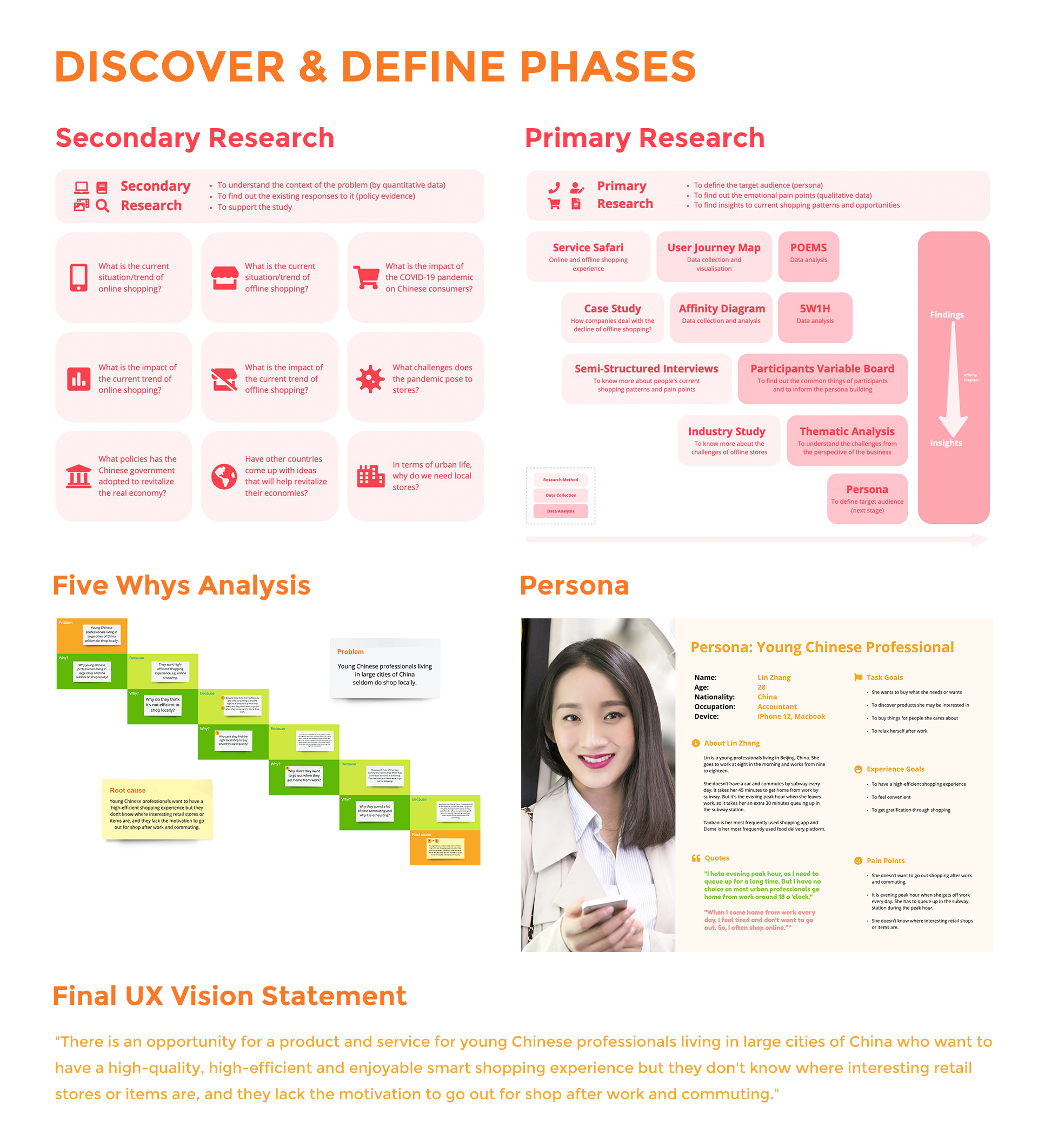
Discover & Define Phases: User Research, Insights & UX Vision Statement
The secondary research was conducted to understand the context of the problem, existing responses to it and the shopping motivations of Chinese consumers, providing some quantitative and qualitative data to support the study.
After contextualising the problem, the primary research was conducted to define the target audience, to find out their emotional pain points and the reasons for their current shopping patterns. Most research was conducted remotely because of the ethical constraints of research under the COVID-19 pandemic.
The primary research included:
• 2 Service Safaris, which recorded the researcher’s online and offline shopping experiences.
• 2 Case Studies on companies' response to offline shopping decline.
• 20 Semi-Structured Interviews with users on their shopping patterns.
• An Industry Study that involved 4 shop owners to understand the challenges that physical stores were facing.
Data were collated and analysed using User Journey Map, POEMS form, Affinity Diagram, 5W1H method, Participants Variable Board, Thematic Analysis and Five “Why's” Analysis.
These phases generate a Persona and a UX vision statement to define the target users and the opportunities. The UX vision statement is: “There is an opportunity for a product or service for young Chinese professionals living in large cities of China who want to have a high-quality, high-efficient and enjoyable shopping experience but they don’t know where interesting retail stores or items are, and they lack the motivation to go out for shop after work and commuting”.
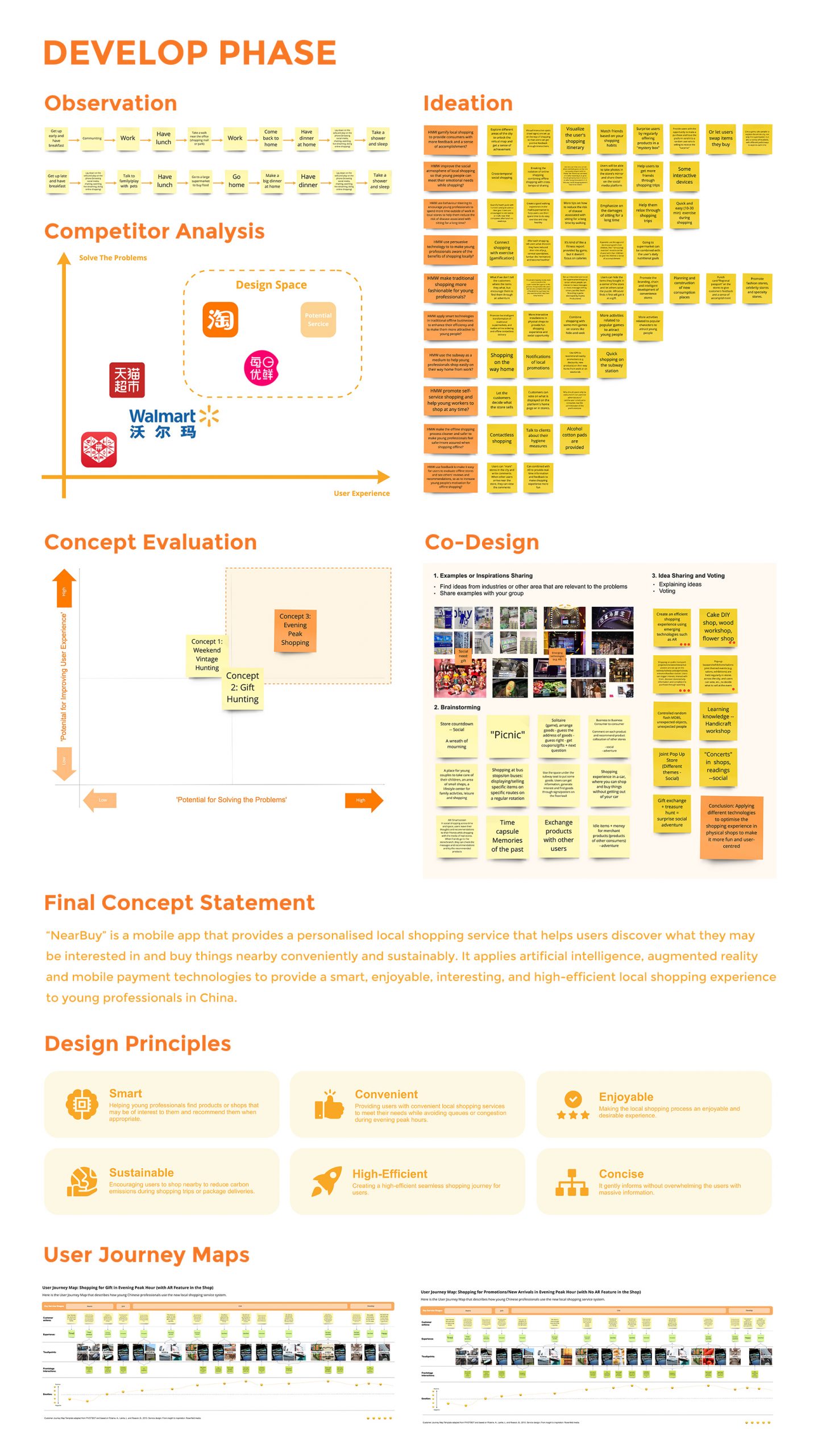
Develop Phase: Observation, Competitor Analysis, Ideation, Evaluation, Co-Design, Design Principles & User Journeys
In the Develop phase, observations and Competitor Analysis were first conducted to find potential design space.
In the ideation, 10 How Might We (HMW) statements and 46 initial ideas were come up with and were then combined into 3 initial user journeys. The 3 concepts were evaluated using an Evaluation Matrix and Concept 3, evening peak hour shopping, was selected to develop.
Some co-design activities and secondary research on technologies were conducted to develop the key features. And 6 participants were invited to vote on some important details of the concept.
The final concept statement is: “NearBuy is a mobile app that provides a personalised local shopping service that helps users discover what they may be interested in and buy things nearby conveniently and sustainably. It applies artificial intelligence, augmented reality and mobile payment technologies to provide a smart, enjoyable, interesting, and high-efficient local shopping experience to young professionals in China.”
Based on the concept, Design Principles were defined to guide the design: smart, sustainable, convenient, high-efficient, enjoyable and concise.
One Storyboard and two User Journey Maps were generated to specify the concept.
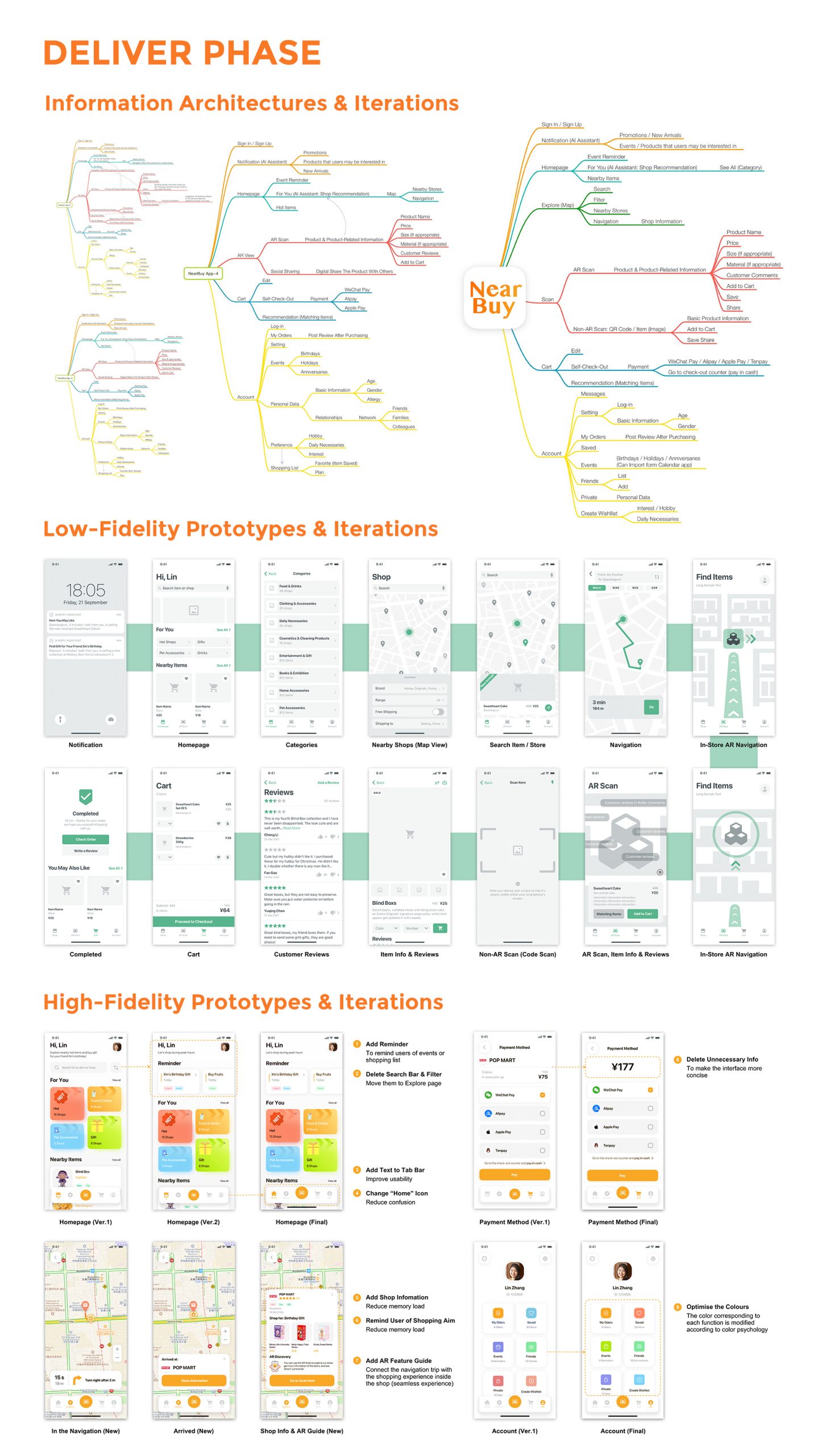
Deliver Phase: Design & Iterations
Based on the User Journey Maps, the Information Architectures were made and iterated based on a retail shopping platform design guideline from a paper.
Then the low-fidelity prototypes were made, and 16 participants aged between 20 and 35 were recruited to test them.
The low-fidelity prototypes were then iterated based on what participants liked and disliked. And a study on Chinese shopping-related UI design patterns was conducted to know what Chinese users are used to and what could be improved in the design.
The high-fidelity prototypes were developed and evaluated using a System Usability Scale (SUS) test which involved 8 target users. The users were generally satisfied with the design, but they also provided some advice. The iterations were made based on their feedback.
After the iterations were completed, EyeQuant, a platform that could predict how users will perceive a design in the first three to five seconds of viewing with the help of artificial neural networks (ANN), was used to test the user interfaces. The clarity score of the high-fidelity prototypes was about 40 points higher than that of most Chinese shopping platforms. This proved that the design was visually successful and could improve the user experience.
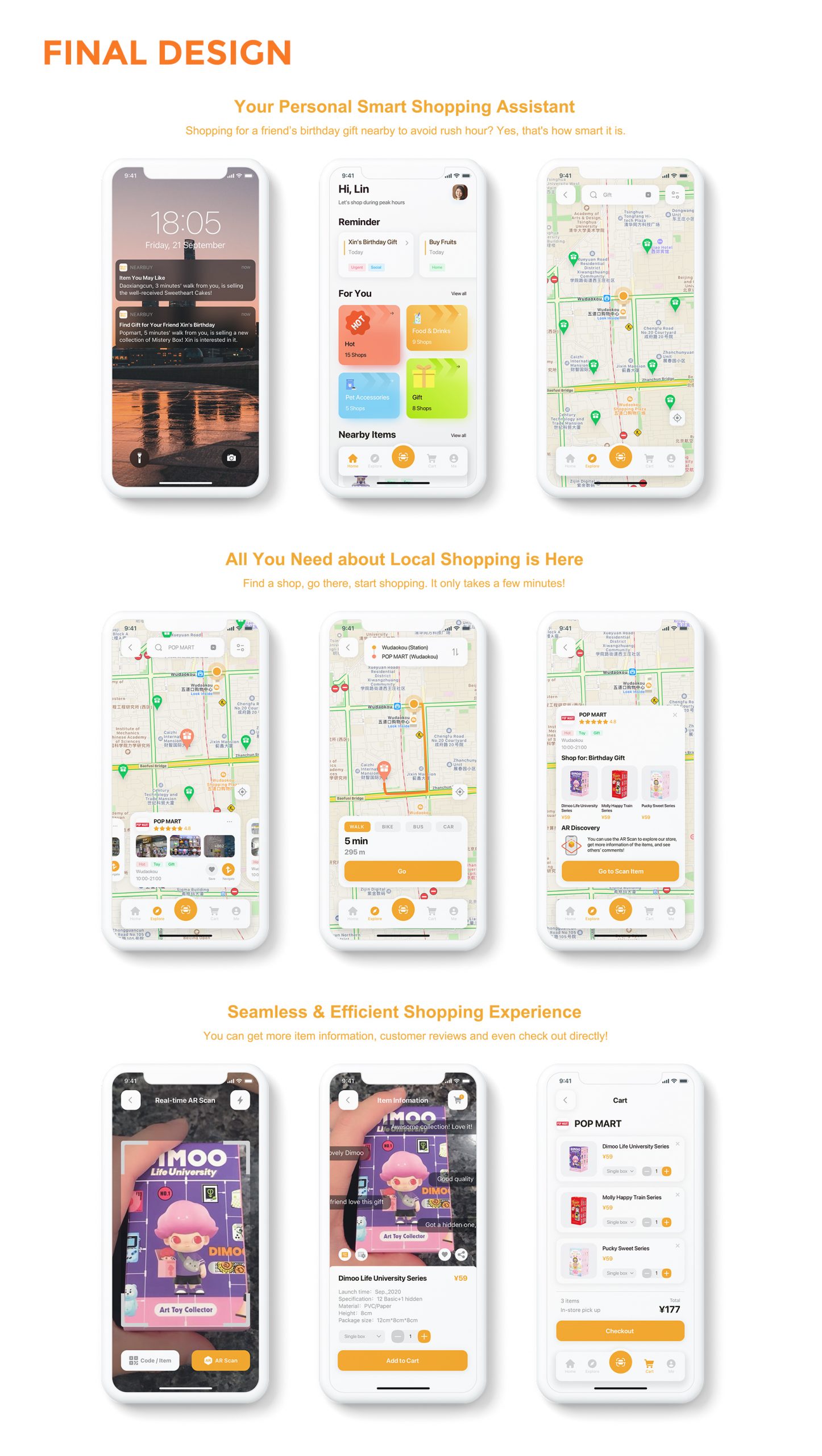
Final Design
NearBuy is your personal smart shopping assistant. For example, on your way home from work, you can shop for a friend’s birthday gift nearby to avoid rush hours. Based on the concept of the “15-minute city”, it aims to help urban residents truly live locally, with the items they need just a short walk or bike ride away. It’s smart and sustainable.
All you need about local shopping is here. Find a shop, go there, start shopping. It only takes a few minutes! It’s useful and convenient.
Furthermore, it creates a seamless & efficient shopping experience. You can get more item information, customer reviews and even check out directly. It’s enjoyable and efficient.
The key features of the NearBuy app are:
• AI assistant (notification: promotions, interests, buy for others; event reminder)
• Nearby shops & items recommendation
• Search (local shops or items)
• Shop information
• Navigation
• AR shopping (AR scan, product information, stock, save, matching items, add to cart, sharing)
• Non-AR shopping (code/item scan, product information, related items, add to cart, sharing)
• Customer reviews ("bullet comments" which provide real-time interactions)
• Self-check-out on the app (mobile payment)
• Personal account (messages, setting, orders, saved items, events management, contact, wishlist, privacy protection)
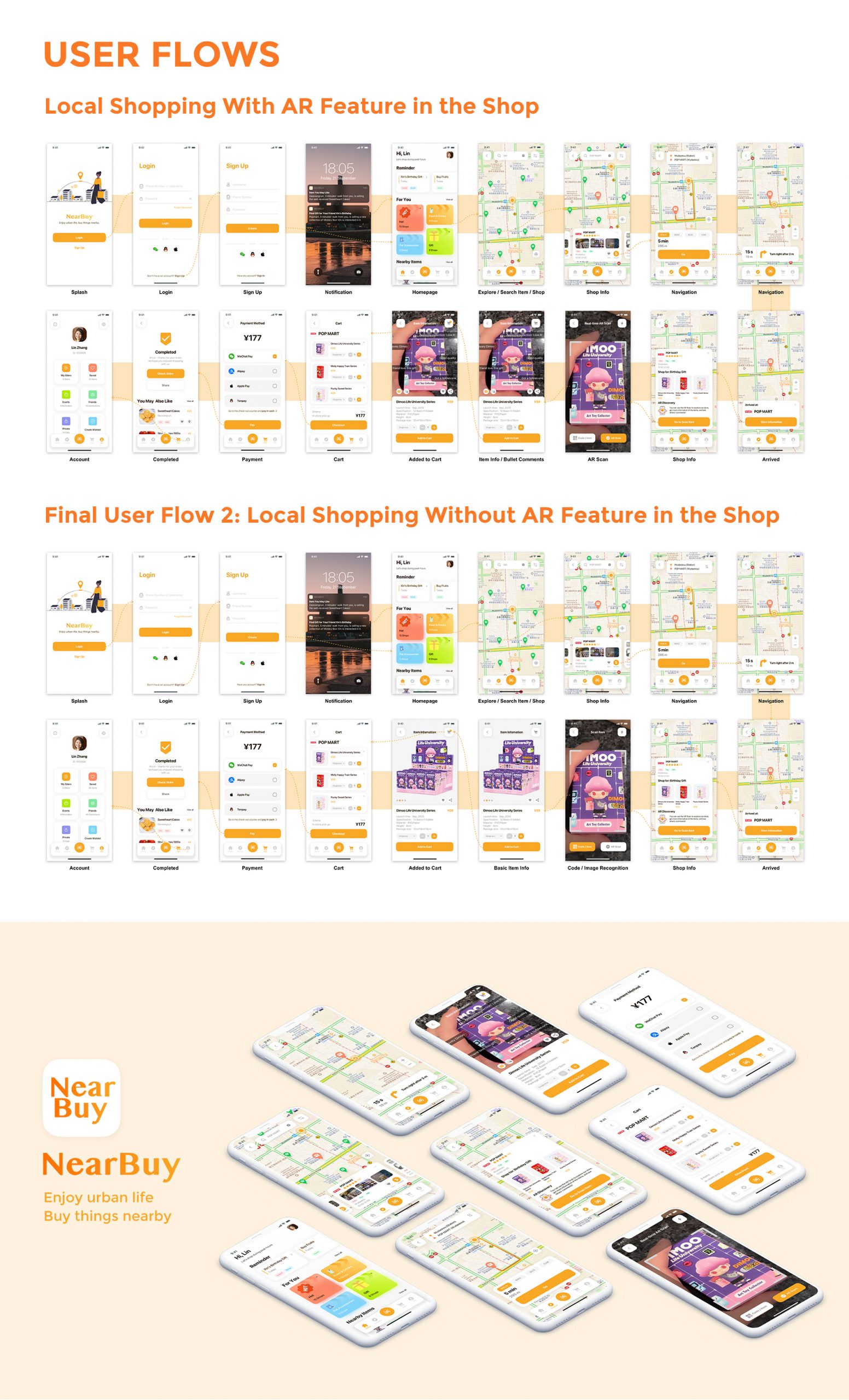
User Flows
NearBuy can reach users tasks & experience goals while solving their pain points. The convenient high-efficient nearby shopping on the way home can motivate users to do more shop locally, which can help save physical shops and boost the real economy. And it also helps reduce carbon emissions while shopping. In brief, it can make a big difference.
Interactive high-fidelity prototypes link: https://xd.adobe.com/view/3ce8a8b0-b715-403c-ba24-783303690396-69bb/?fullscreen
Siqi He
A passionate designer and responsible problem solver, dedicated to creating a better life for human through design and business
Major project
NearBuy: A Smart, Efficient, Sustainable And Enjoyable Local Shopping System